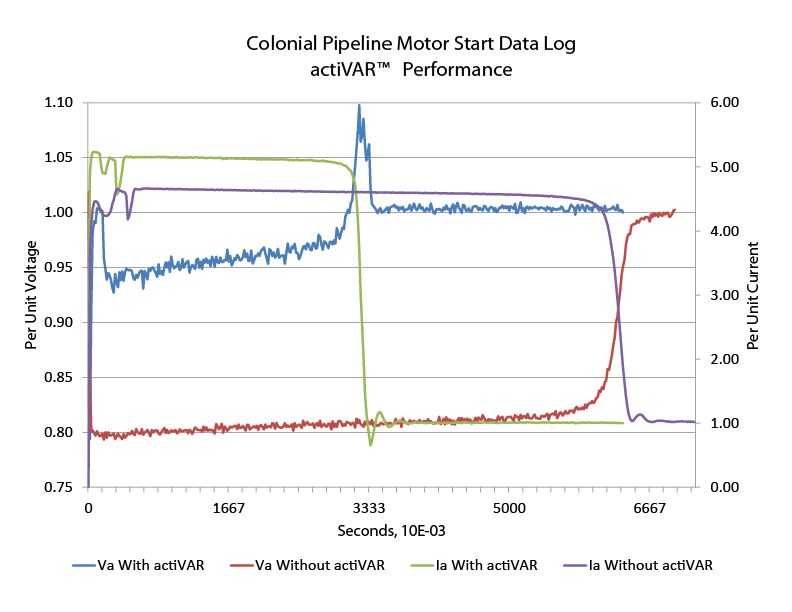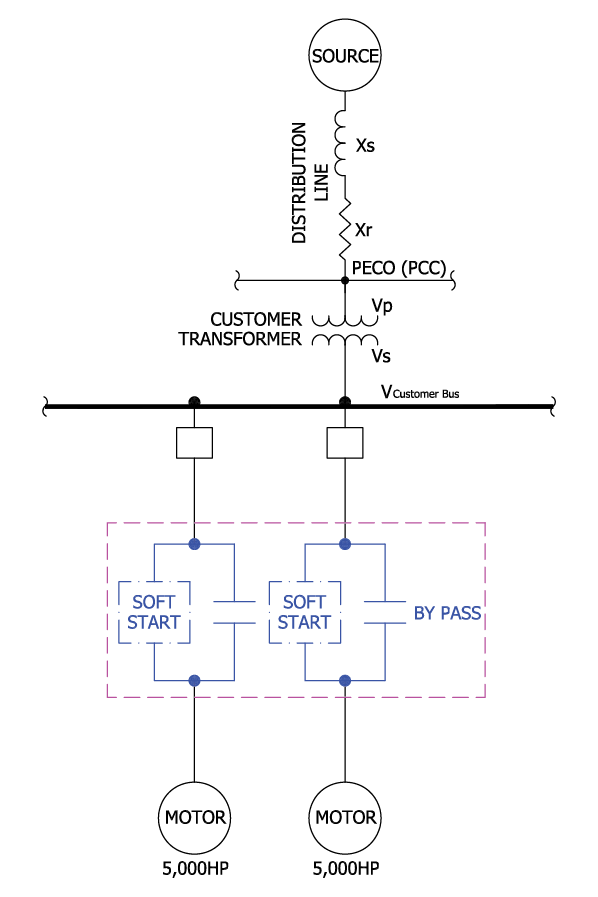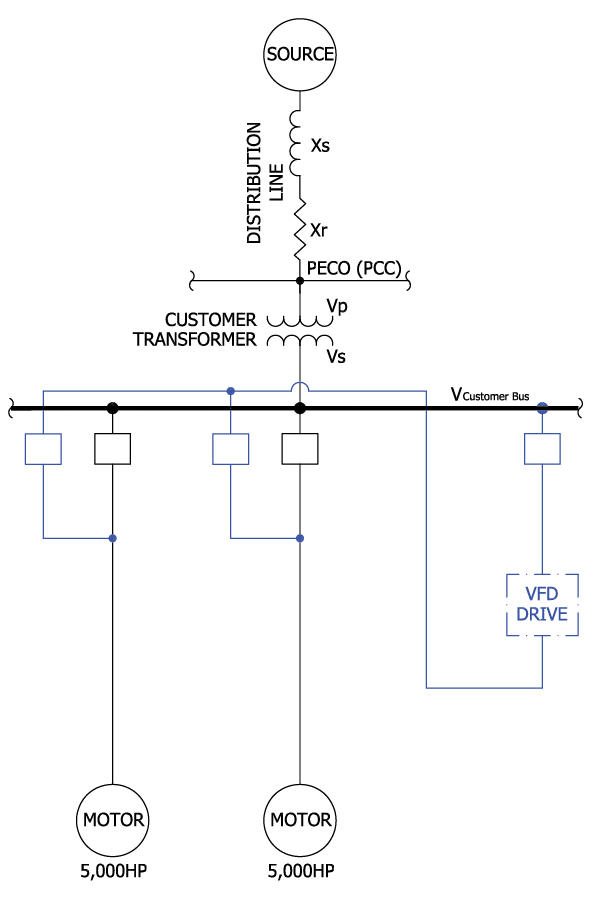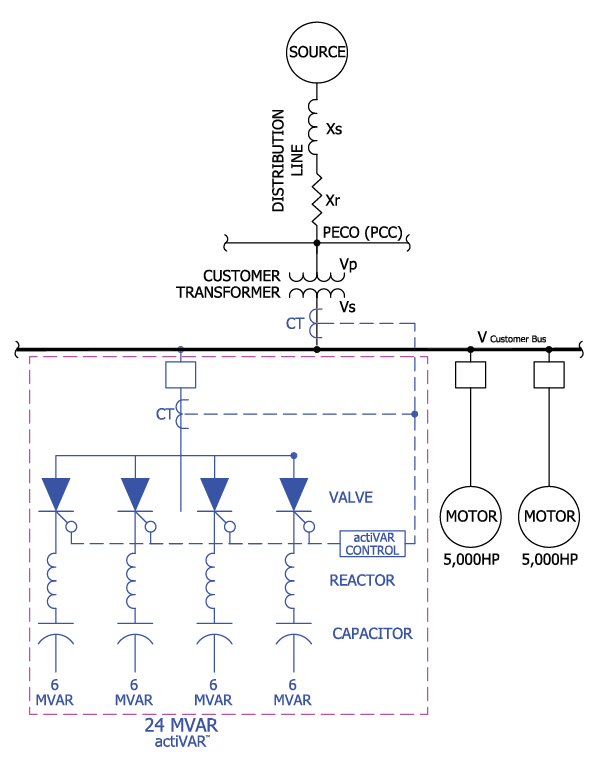NEPSI's actiVAR Helps Colonial Pipeline Company Meet PECO's Voltage Sag Limit During Motor Starting
Share this article:
Tuesday Oct. 21, 2014
Colonial Pipeline Company (CPC) worked with NEPSI and T-Star Engineering and Technical Services (T-STAR) to provide engineering, product application support, and an actiVAR at their Brandywine Station in Boothwyn, PA. The actiVAR was designed to meet CPC's electric service providers voltage sag constraint of 95% at their point-of-common coupling (PCC) - Allowing Continued Operation of Their Brandywine Station.

Background
CPC transports refined petroleum products such as gasoline, diesel fuel, jet fuel, home heating oil, and fuels for the U.S. military. Their pipeline consists of more than 5,500 miles of underground pipe, above ground storage tanks, and pump stations.
The Brandywine Pump Station, was built many years ago on the once rural, outskirts of Philadelphia. The station receives its electric power from a 34.5kV overhead distribution line in PECO Energy's (Philadelphia Electric and Gas Company) service territory.
Since the station's construction, the area and number of customers receiving power from the distribution line had become densely populated. Residents near the CPC station frequently complained of random voltage flicker, which upon investigation lead PECO Energy to CPC's Brandwine Pump Station.
PECO determined that two 5000 HP induction motors at CPC's Brandywine Pump Station were causing voltage sags near 84% on their 34.5kV line. PECO service agreement mandates the maximum voltage sag be no less than 95% during motor starts.
Defining the Problem
When CPC starts their 5000 HP Induction Motors, a sizable inrush current of 3,130 amps, commonly referred to as the induction motor's locked rotor current, is drawn through PECO's 34.5kV network (see figure 1). The inrush current, (Istart) is predominately inductive, and as such contributes to a significant voltage drop (VDROP) at the utility's point of common coupling (noted as PCC in figure 1).
The voltage drop at the motor is even greater as the inrush current flows through the leakage reactance of the CPC transformer. Measurements taken during motor starts showed voltage drops at the 4.16kV bus near 26%.
Current technologies to fix voltage sags associated with motor starting usually involve reducing the current to the motor by decreasing the terminal voltage at the motor (most often by use of an RVSS or VFD). The actiVAR has replaced these technologies as a better solution.
Figure 1 (Right) - Complaints by PECO customers about voltage flicker necessitated a solution to voltage sags caused by CPC's 5000 HP Pumps. Motor starting currents in the range of 3,130 amps was causing voltage dips of 16% (84% voltage sags) to nearby residence. Click to enlarge.
Possible Solutions
Several options including Reduced Voltage Soft Starts (RVSS), Variable Frequency Drive (VFD) Starters, conventionally switched capacitor banks (using circuit breakers to
switch the capacitor banks), and NEPSI's actiVAR were investigated.
Conventionally switched capacitor banks using circuit breakers or switches were too slow. The RVSS was ruled out as it could not meet PECO's voltage sag limits. The VFD starter met PECO's voltage sag limits, but was not pursued due to high costs, E-house space requirements, and the clear advantages of NEPSI's actiVAR.
The actiVAR reduces the system's inrush current by using DS1M switched capacitor banks to locally supply the motor's inrush current and reactive power. Being a local source of reactive power, the actiVAR eliminates the voltage drop associated with the inrush current through PECO's line impedance as previously noted in figure 1. The actiVAR responds to all motor starts on the system within ONE cycle without the requirement for bypass switchgear or synch switchgear.

RVSS Start
Advantages
- Lowest cost option
Disadvantages
- Did not meet utility voltage sag requirements for required starting torque. (Remember—starting torque varies by the square of the voltage. At 80% voltage, the available startingtorque is at 65%.)
- Required significant changes to site to re-route motor cables through RVSS
- E-House space was not available
- Harmonics

VFD Start
Advantages
- Met utility voltage sag requirements
- Near full torque at starting
- Started current reduced by as much as 90%, meeting utility voltage sag requirements
- Soft start
Disadvantages
- E-Housed space requirements for VFD breaker and sync switchgear
- Highest installed cost option
- Harmonic concerns
- Long production and delivery time due to equipment complexity

actiVAR Start
Advantages
- Met utility voltage sag requirements
- Lower cost when compared to VFD start option
- Most simple of all options to install and maintain
- Near full torque at starting, with full torque possible if sized for no voltage sag (100% reactive power compensation)
- Outdoor rated for installation in switchyard
Disadvantages
- None
Conclusion
The actiVAR provides a simple cost effective means of mitigating voltage sags from starting of large induction motors and synchronous motors. It allows for full-torque motor
starts at a fraction of the cost of a VFD starter and synch switchgear package. With the benefits of eliminating E-House space, cooling requirements, and harmonics concerns, the actiVAR is
the better solution where VFD drives and RVSS are being considered for large motor starting.

Figure 2 – Actual voltage and current logged by the actiVAR's controller at CPC's 4.16kV Bus during commissioning.






Follow us on social media for up-to-date news, videos, and other information: